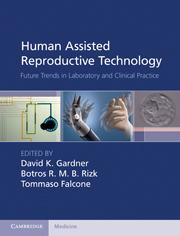Crossref Citations
This Book has been
cited by the following publications. This list is generated based on data provided by Crossref.
McKeegan, Paul J.
and
Sturmey, Roger G.
2012.
The role of fatty acids in oocyte and early embryo development.
Reproduction, Fertility and Development,
Vol. 24,
Issue. 1,
p.
59.
LEE, WOOWON
KABIR, MOHAMMAD M.
EMMADI, RAJYASREE
and
TOUSSAINT, KIMANI C.
2016.
Third‐harmonic generation imaging of breast tissue biopsies.
Journal of Microscopy,
Vol. 264,
Issue. 2,
p.
175.
Samuel, Raheel
Badamjav, Odgerel
Murphy, Kristin E.
Patel, Darshan P.
Son, Jiyoung
Gale, Bruce K.
Carrell, Douglas T.
and
Hotaling, James M.
2016.
Microfluidics: The future of microdissection TESE?.
Systems Biology in Reproductive Medicine,
Vol. 62,
Issue. 3,
p.
161.
Javed, Aamir
Ramaiah, Manjula Kannasandra
and
Talkad, Muralidhar Srinivasaih
2019.
ICSI using fresh and frozen PESA-TESA spermatozoa to examine assisted reproductive outcome retrospectively.
Obstetrics & Gynecology Science,
Vol. 62,
Issue. 6,
p.
429.
Al‐Wattar, Bassel H.
and
Khan, Khalid S.
2021.
Assisted Reproduction Techniques.
p.
706.
Palmerini, Maria Grazia
Antonouli, Sevastiani
Macchiarelli, Guido
Cecconi, Sandra
Bianchi, Serena
Khalili, Mohammad Ali
and
Nottola, Stefania Annarita
2022.
Ultrastructural Evaluation of the Human Oocyte at the Germinal Vesicle Stage during the Application of Assisted Reproductive Technologies.
Cells,
Vol. 11,
Issue. 10,
p.
1636.



